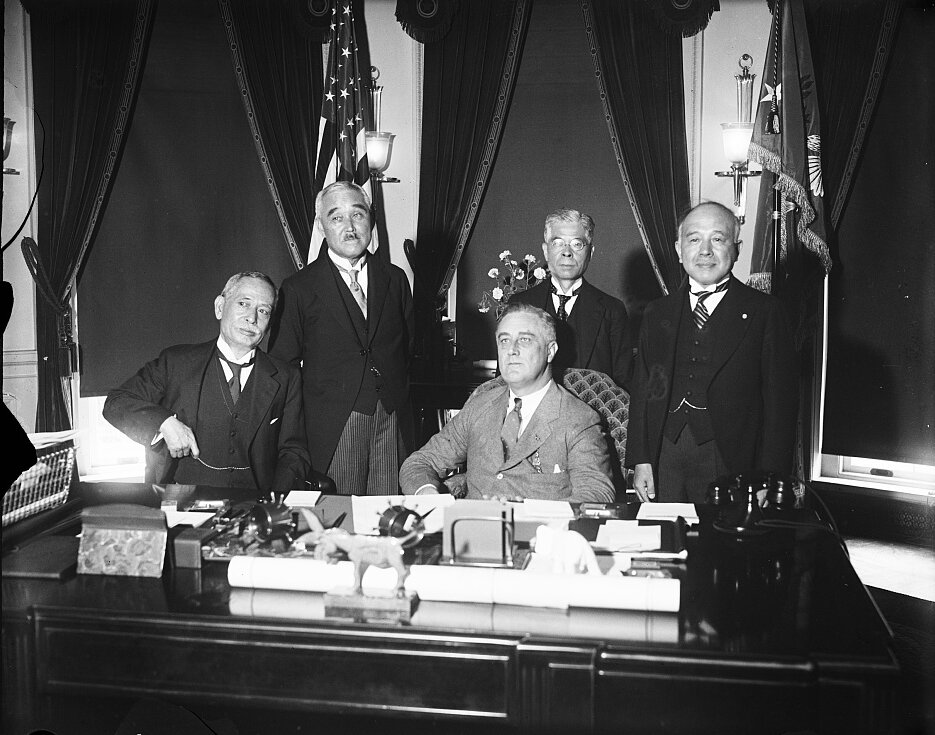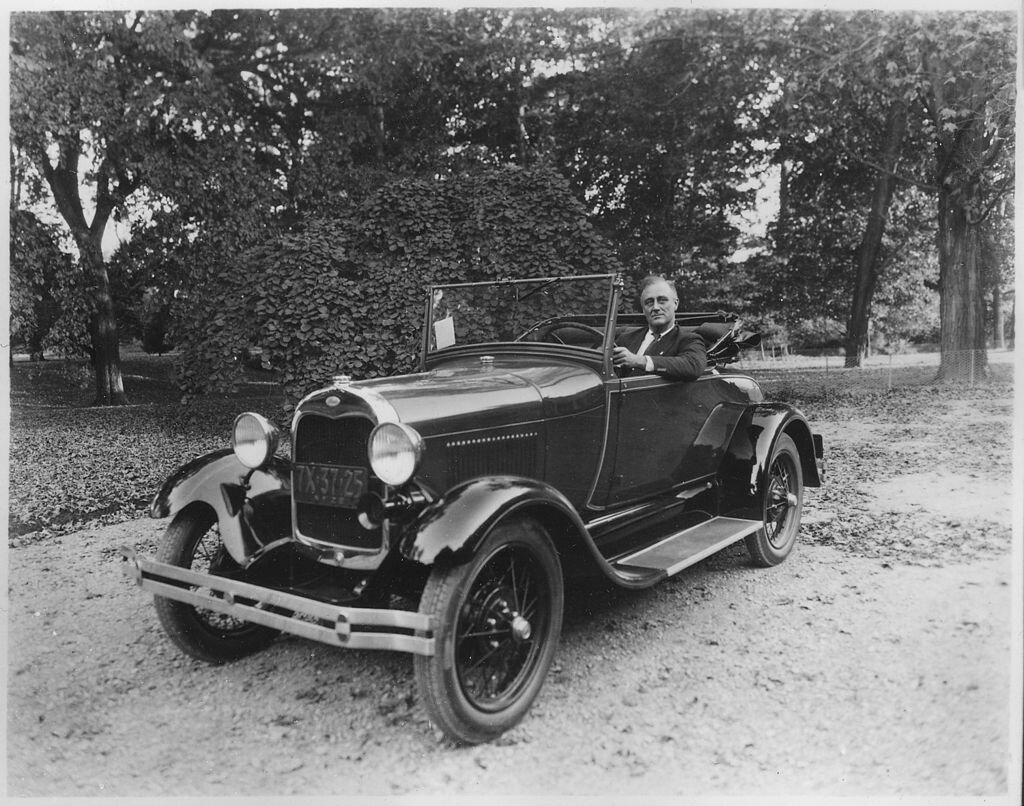Franklin Delano Roosevelt was president of the USA from 1933 to 1945. He led the country out of the Great Depression and into World War Two. But, was he the ideal Democrat? Here, Donna Catapano argues that while his economic policies suggest he is, his social policies suggest otherwise - notably on issues of race.
Franklin D. Roosevelt meeting a Japanese delegation in the White House in 1933. During World War Two, Japanese Americans would be interned under Roosevelt’s presidency. Picture source: Harris & Ewing, available here.
Franklin Roosevelt is often looked at today by people as the “ideal Democrat”; the person who shaped the present-day Democratic Party. Many of those people, including educators, discuss this turning point in history when Roosevelt “made” what the Democrat is today. When Roosevelt won the Presidential Election in 1932 by a landslide against Republican Herbert Hoover, the Democratic Party was introduced to a new level of government involvement. Even though his economic ideologies would still be considered relevant to Democrats today, his social ideologies would not. His dismissal of the social issues of the 1930s and 1940s caused a ripple effect that we are still feeling in 2020. Roosevelt’s social principles, including those regarding lynching, racial profiling and discrimination within his New Deal programs, contradicts his status as the “ideal Democrat.”
As the years went on, the “Democrat” as we know it today, who is one who typically is in favor of federal government spending for public programs, associated those beginnings with FDR. Therefore, people typically describe Roosevelt as the “ideal Democrat”. However, one can argue that in 2020, Roosevelt would not be deemed that way. In his 12 years as president, he took many actions that today might fall elsewhere on the political spectrum. Although he took several actions (and inactions) that might raise further questioning, three stand out.
1. His refusal to sign a federal anti-lynching bill
Between the years 1882 and 1968, more than 3,500 African Americans were murdered by white mobs. At the time, almost none of them were arrested and/or convicted for their brutal crimes. What emerged was an anti-lynching movement, whose participants demanded government action to stop these hate crimes. The extent to which Roosevelt spoke out against lynching was a fireside chat on December 6, 1933, when he briefly discussed the “vile form of collective murder -- lynch law-- which has broken out in our midst anew”. He went on to very briefly condemn the issue, stating: “We know that it is murder, and a deliberate and definite disobedience of the Commandment, ‘Thou shalt not kill’. We do not excuse those in high places or in low who condone lynch law.” Twenty-eight African Americans were lynched the same year he gave this 1933 fireside chat. However, First Lady Eleanor Roosevelt spoke out against lynching on several occasions, joining the National Association for the Advancement of Colored People (NAACP) in Roosevelt’s first term in 1934 and having a close professional relationship with its president at the time, Walter White. She even went so far as to set up a meeting with White and her husband to encourage Franklin to publicly support the Costigan-Wagner bill, which he refused. Roosevelt stated to White at their meeting:
“If I come out for the anti-lynching bill now, they will block every bill I ask Congress to pass to keep America from collapsing. I just can’t take the risk.”
Roosevelt stood his ground, fearful that the Southern Democrats in Congress, representatives he relied on to get his New Deal programs passed, would turn their back on him and the New Deal. One can ponder: If FDR was president today, would he back the #blacklivesmatter movement, or would he spend more time worrying about his own Congressional agenda?
2. Japanese Internment during World War II
During the Second World War, the federal government saw Japanese American citizens as a threat. However, when President Roosevelt passed Executive Order #9066 in 1942, it made it acceptable for the Secretary of War and any designated Military Commanders to:
“Whom he may from time to time designate, whenever he or any designated Commander deems such action necessary or desirable, to prescribe military areas in such places and of such extent as he or the appropriate Military Commander may determine, from which any or all persons may be excluded, and with respect to which, the right of any person to enter, remain in, or leave shall be subject to whatever restrictions the Secretary of War or the appropriate Military Commander may impose in his discretion”.
Moreover, it made it legal for said Commanders to prescribe what they called “military areas”, or relocation camps, for any and every person they deemed necessary: in this case, Japanese Americans. This executive order essentially allowed Japanese American citizens to be removed from their homes and relocated to internment camps where they were not allowed to leave, for not committing any crime but being of Japanese descent. This was perhaps one of the largest government-run racial profiling events in American history, and Roosevelt labeled it “A-OK”. One may ponder: how does this make Roosevelt different from the present-day with the current level of racial profiling that takes place for minorities such as African Americans, Hispanic Americans, and Muslim Americans?
3. A New Deal for Some of the American People
When you learn about FDR in school, you most likely associate him with the New Deal and how it helped the American people recover from the Great Depression. As mentioned above, these federally funded programs were set out to create and give jobs to suffering citizens. However, it did not include all Americans. For example, the National Recovery Administration (NRA) of 1933 “not only offered whites the first crack at jobs, but authorized separate and lower pay scales for blacks”. Furthermore, the Federal Housing Authority (FHA) of 1934 “refused to guarantee mortgages for blacks who tried to buy in white neighborhoods,” and the Civilian Conservation Corps (CCC) of 1933 created to employ young men on environmental projects, maintained segregated camps. According to author Eric Rauchway, “Roosevelt never said anything outwardly about the fact that minorities were the last to get hired for New Deal jobs”. Once again, Roosevelt appealed to the conservative southern Democrats who were influential in Congress and oversaw many committee chairmanships, in fear of them blocking his pieces of legislation if he got involved with the “race question”. One may ponder: How might Roosevelt have handled job discrimination in 2020?
Conclusion
The aforementioned reasons why President Roosevelt may not be seen as the “ideal Democrat” of 2020 are a few of a number of examples we can consider. Segregation in the military existed and he did not speak out against it. Regarding the Nazi persecution of Jews, he did not actively intervene or welcome Jewish refugees to the United States.
Franklin Roosevelt did much for the United States as a country economically. He revolutionized certain aspects of the Democratic Party, while staying silent on the pivotal social issues of the time. The birth of the present-day Democrat can be accredited to Roosevelt when it comes to the involvement of the federal government in citizen’s livelihoods, but not the social issues of the 1930s and 1940s.
So, in 2020, would FDR be considered the ideal Democrat? Let us know what you think below.
















